Offices
Australia, New Zealand, Canada, USA
Work Hours
Monday to Friday: 7AM - 7PM
Offices
Australia, New Zealand, Canada, USA
Work Hours
Monday to Friday: 7AM - 7PM


As artificial intelligence (AI) and, more specifically, generative AI (GenAI) continue to revolutionize systems and processes, it is imperative for organizations, especially in the public sector, to prioritize the development of an AI-ready workforce. This entails equipping employees with the necessary skills and knowledge to leverage AI technologies effectively, thereby enhancing public service delivery and driving overall transformation.
With the myriad of AI training options available, determining the essential skills for employees can indeed appear overwhelming. However, a strategic approach can help employees and their supervisors identify the mission-critical AI skills that are vital for success in an AI-driven environment.
One of the most effective ways to build an AI-ready workforce is through reskilling opportunities and targeted training initiatives. Organizations can collaborate with learning and development experts to design comprehensive programs that cater to the specific AI skill requirements within the public sector. These initiatives should encompass a blend of technical AI skills, such as machine learning and natural language processing, as well as non-technical skills like critical thinking, problem-solving, and creativity, which are invaluable in harnessing the full potential of AI.
Furthermore, leveraging advanced AI platforms, such as chatGPT and other generative AI models, can provide employees with hands-on experience in utilizing AI for public service delivery. This practical exposure can significantly enhance their proficiency and confidence in working with AI technologies, ultimately contributing to the development of a highly competent and adaptable workforce.
Moreover, prompt engineering, which involves crafting precise and effective prompts for AI models, is an emerging skill that holds immense significance in optimizing AI systems for specific public service tasks. By integrating prompt engineering into training initiatives, employees can gain a deeper understanding of how to effectively communicate with AI systems and extract meaningful insights to drive informed decision-making within the public sector.
It is essential for organizations to adopt a proactive stance in identifying reskilling opportunities and investing in comprehensive training programs to ensure that their workforce remains agile and proficient in an AI-driven landscape. By empowering employees with the requisite AI skills, organizations can not only enhance public service delivery but also foster a culture of continuous learning and professional growth.
In order to build an AI-ready workforce, it is crucial to foster a culture of continuous learning within the organization. Employees should be encouraged to stay up-to-date with the latest advancements in AI and actively seek out opportunities for professional development and skill-building. This can be achieved through a variety of initiatives, such as in-house training programs, online courses, industry events, and peer-to-peer knowledge sharing sessions.
By creating an environment that values and supports ongoing learning, organizations can empower their employees to adapt to the rapidly evolving technological landscape and remain competitive in the face of AI-driven transformation.
As AI continues to automate and streamline various tasks, the ability to adapt to change and solve complex problems will become increasingly valuable. Employees must be equipped with the cognitive agility to thrive in an AI-centric work environment, where the nature of their roles and responsibilities may shift over time.
Investing in training programs that focus on developing critical thinking, problem-solving, and decision-making skills can equip employees with the tools necessary to navigate the dynamic challenges presented by AI integration. By fostering these essential competencies, organizations can ensure that their workforce is well-prepared to collaborate with AI systems and leverage their capabilities to enhance productivity and service delivery.
The successful integration of AI within an organization requires a shift in mindset, where employees view AI as a collaborative partner rather than a replacement for human labor. Cultivating a culture of “collaborative intelligence” empowers employees to harness the strengths of both human and artificial intelligence, resulting in synergistic and innovative outcomes.
Training programs should encourage employees to understand the complementary roles of human and AI capabilities, and how to effectively work alongside AI systems to augment their own skills and decision-making processes. This collaborative approach can lead to enhanced problem-solving, increased efficiency, and a more engaged and empowered workforce.
As the use of AI becomes more widespread, it is essential that organizations prioritize the ethical and responsible deployment of these technologies. Employees must be trained to understand the potential risks, biases, and privacy implications associated with AI systems, and be equipped with the knowledge to mitigate these challenges.
This includes training on data privacy, algorithmic bias, transparency, and accountability in the use of AI. By instilling a strong ethical foundation, organizations can ensure that their AI-ready workforce is equipped to navigate the complex ethical landscape and uphold the principles of responsible AI governance.
Once an AI-ready workforce is established, organizations should leverage the capabilities of AI to drive continuous improvement and enhance their overall performance. This can involve using AI-powered tools for data analysis, process optimization, predictive modeling, and automated decision-making, among other applications.
By empowering employees to integrate AI into their daily workflows, organizations can unlock new efficiencies, identify areas for improvement, and make more informed, data-driven decisions. This, in turn, can lead to improved service delivery, streamlined operations, and increased public trust in the government’s ability to leverage technology for the greater good.
As the public sector continues to navigate the transformative impact of artificial intelligence, the development of an AI-ready workforce is a critical imperative. By equipping employees with the necessary skills, knowledge, and mindset, organizations can harness the power of AI to enhance public service delivery, improve operational efficiency, and drive innovation.
Through a comprehensive approach that encompasses continuous learning, adaptability, collaborative intelligence, ethical practices, and the strategic integration of AI, government agencies can position their workforce for success in the AI-driven future. By embracing this revolution, public sector organizations can unlock new opportunities to better serve their communities and fulfill their mission-driven mandates.